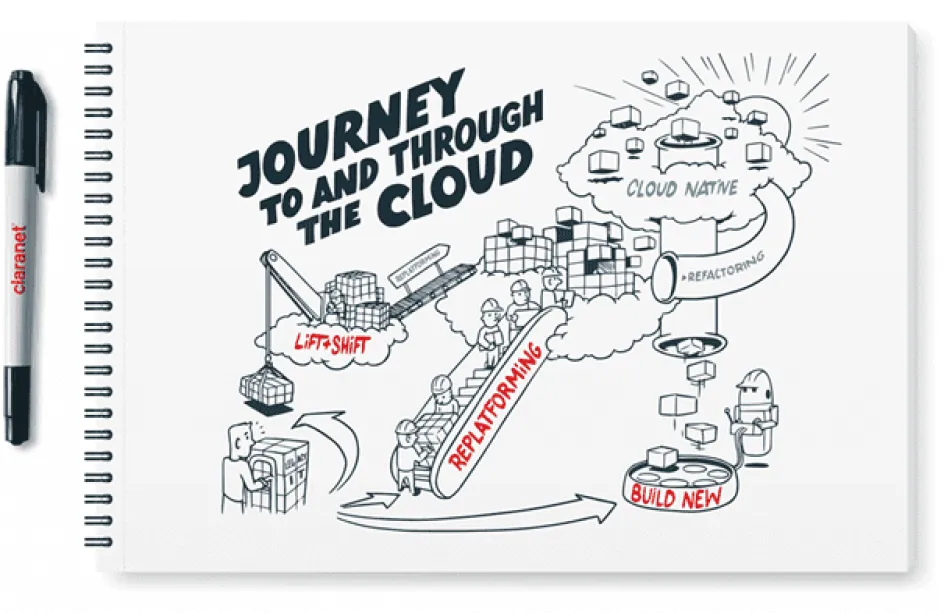Companies on their Cloud Journey: Strategies and tips for cloud migration projects

Michaela Jackel
Marketing Specialist
"Adapt or perish!" – this saying holds particularly true in times of crisis. Increasingly, companies are recognizing that outdated IT systems not only pose significant risks but also hinder their ability to compete effectively on both national and international stages. Many have come to understand that transitioning to the cloud is a critical step toward achieving digital transformation. In this blog post, we explore how companies are navigating their cloud migration journeys, the challenges they encounter, and the strategies they employ. You'll gain insights into migration approaches, examples, and practical tips to help guide your own transformation.
Cloud migration: The status quo
A recent study conducted by Computerwoche on cloud migration reveals that many businesses in Germany remain cautious about transitioning to the cloud, despite the mounting pressure to innovate. Only 38% of respondents have successfully completed at least one cloud migration project, with larger corporations leading the way ahead of small and medium-sized enterprises (SMEs). Meanwhile, a quarter of the surveyed companies are planning cloud migration projects within the next year, and around 20% anticipate initiating such projects within the next one to three years.
The hesitancy to embrace cloud migration is predominantly attributed to technical and organizational challenges. Common technical hurdles include IT infrastructure limitations, concerns about data protection and compliance, as well as data security issues. On the organizational side, respondents often cite the complexity of cloud migration, lengthy project timelines, constrained budgets, and insufficient support from management as key obstacles.
Why companies should prioritize IT modernization and cloud migration
There are numerous compelling reasons to modernize IT systems and migrate to the cloud. Below are five of the most frequently cited benefits:
- Cost efficiency: Operating and maintaining legacy IT costs more and more. Modern IT solutions give companies the freedom to innovate and often also cost advantages.
- Innovation enablement: Static IT concepts slow down innovative business processes, while agile IT ensures sufficient flexibility and accelerates digitalisation.
- Simplification: Old system landscapes require a lot of maintenance work. Cloud and DevOps concepts reduce the effort and increase reliability at the same time.
- Enhanced security: Grown IT environments are often opaque. Only advanced cyber security approaches ensure adequate protection for the company.
- Addressing skills shortages: IT specialists for urgently needed modernisation projects are rare. Specialised service providers offer professional support.
Cloud roadmap: Basics for preparing your journey
Choosing the right cloud migration strategy depends not only on technical considerations but also on your organization's overarching cloud strategy. To navigate the complexities of cloud migration effectively, managers should address the following six key questions:
- What business opportunities and challenges does cloud technology present for my organization?
- What is the current state of my IT infrastructure, including specific requirements for data security and compliance?
- Which existing workloads (applications, data, processes, and resources) are cloud-ready, and what adjustments are necessary for the others?
- Which cloud platforms and services best align with my business needs?
- What migration approach is most suitable given my starting point and objectives?
- What does my target architecture and preferred operating model look like?
Operational strategies for cloud migration
There are multiple paths to the cloud, each tailored to an organization’s needs, resources, and objectives. Below are three common approaches:

- Lift & Shift: This strategy involves migrating existing workloads to the cloud with minimal adjustments. While it is the quickest and simplest method, it often fails to leverage the full capabilities of cloud infrastructure, limiting its potential benefits.
- Modernisation: This middle-ground approach focuses on transforming and optimizing existing solutions for cloud operation. It includes two subcategories:
- Replatforming: Applications remain largely unchanged, but selected cloud services are integrated to enhance functionality.
- Refactoring: Applications are comprehensively modernized using agile methodologies to achieve a "cloud-native" state.
- New development: This is the ideal scenario for maximizing cloud benefits. Applications and workloads are rebuilt from scratch using agile, cloud-native methodologies, including containerization, microservices, DevOps, CI/CD, serverless computing, and cloud orchestration. While time-intensive, this approach unlocks the full potential of cloud technology.
Post-migration: Maintaining and optimizing your cloud environment
Successfully migrating to the cloud is a significant milestone, but it’s not the end of the journey. While many processes are automated in the cloud, the responsibility for maintaining and optimizing the infrastructure remains with the organization. Cloud providers, particularly hyperscalers, deliver foundational infrastructure and services, but businesses must ensure the smooth operation, security, and continuous improvement of their systems, applications, services, and data.
To alleviate the operational burden, many companies opt for managed services from providers like Claranet. These services ensure that workloads and environments are maintained efficiently while freeing internal teams to focus on strategic priorities.
For a deeper dive into shared responsibility models and practical cloud migration strategies, we recommend Claranet’s whitepaper "Journey to the Cloud". On 14 pages, it explores innovative projects such as the collaboration with Hamburger Hochbahn AG, various migration approaches, and the principles of "cloud-native" operations. Additionally, readers interested in personalized advice can participate in the free Cloud Exploration Workshop to identify the best cloud strategy for their organization.
Thank you for reading and have a good journey!
